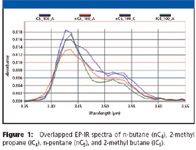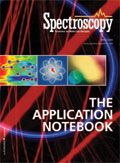Differentiation of Hydrocarbon Homologs Using EP-IR Spectroscopy
Application Notebook
EP-IR Spectrometry -- a cost-effective, rugged and compact high scanning speed full-spectrum technology -- provides a means to simultaneously measure spectrally overlapping compounds without false positive response, considerably exceeding TUEV and MCERTS analytical requirements for cross sensitivity.
EP-IR Spectrometry — a cost-effective, rugged and compact high scanning speed full-spectrum technology — provides a means to simultaneously measure spectrally overlapping compounds without false positive response, considerably exceeding TUEV and MCERTS analytical requirements for cross sensitivity.
Encoded photometrics infrared (EP-IR) spectrometry is a novel approach to capture full spectrum information in the infrared region. This patented technology [1] relies upon the post-dispersive modulation of polychromatic IR light using a high speed rotating encoder disk and a single point detector. EP-IR spectrometers contain no hygroscopic parts, have only one moving part and can accommodate, by design, two detectors for collection of spectral information in two regions (e.g., mid and near IR, simultaneously using a single spectrometer). EP-IR spectrometers were designed and engineered as cost-effective solutions for industrial integrated applications.
A key to understanding EP-IR spectrometry and its power of analytical resolution and specificity is to realize that each data point plotted on an EP-IR spectrum does not represent a measured intensity (absorbance) at that wavelength (frequency), but the integration of any and all vibrational energy information comprised within the bandwidth of each contiguous photometric channel. The net result is that, despite appearances with the display of spectra consisting of only 128 or 256 data points (corresponding to the information pertaining to 128 or 256 photometric channels), EP-IR spectrometry offers a great deal of analytical resolution. Proof is in the results of an experiment that consists of the development of multivariate chemometrics methods for the simultaneous measurement of four hydrocarbon homolog gases and tests the power of analytical resolution of EP-IR spectrometry against established analytical standards as published by TUEV and MCERTS [2].
Experimental
An Aspectrics 256-channel EP-IR spectrometer was used with a 25.4 cm gas cell. Sufficient data were collected for the simultaneous measurement of n-butane (nC4), 2-methyl propane (iC4), n-pentane (nC5), and 2-methyl butane (iC5) in the 0–100 ppm concentration range (primary reference grade quality gases.) A computer-controlled gas blender using mass flow controllers and equipped with five lines was used to deliver controlled concentrations of gases to the gas cell and EP-IR spectrometer.
Two sets of data were collected. The first consisted of calibration spectra used to develop a chemometrics model for the simultaneous measurement of all four hydrocarbon homolog. The second one was an independent run designed to test the analytical resolution capabilities of the instrument and chemometrics model. Analytical resolution was evaluated against TUEV and MCERTS standards for cross sensitivity.

Figure 1: Overlapped EP-IR spectra of n-butane (nC4), 2-methyl propane (iC4), n-pentane (nC5), and 2-methyl butane (iC5).
Results
Figure 1 represents the EP-IR spectra of the four hydrocarbon homolog gases in the C-H stretch region. Please note that all four gases are spectrally highly overlapped. A formal qualification of EP-IR analytical resolution and specificity appears in Table I, which reports the cross sensitivity between all four hydrocarbon homolog compounds. We observe that the TUEV cross sensitivity analytical requirement of < ± 4% relative is not only met, but largely exceeded by the EP-IR spectrometer's performance.

Table 1. Simultaneous Analysis of (nC4), (iC4), (nC5), (iC5). Analytical resolution evaluation against TUEV 4201 & MCERTS 323 cross sensitivity minimum analytical requirements for multicomponent emissions analysis. TUEV 4201 requirement for cross sensitivity is
Conclusions
EP-IR spectrometry is a novel technological approach to collecting infrared spectral information. It is quite different from other existing technologies. Its overall performances should therefore be evaluated using tools different from those typically used for other forms of full-spectrum spectrometry. This is why focusing on the final result, the analytical performance, is the only way to compare and appreciate EP-IR true capabilities.
References
(1) US Patents 6,271,917; 6,388,794; 6,762,833; 6,897,952; 6,982,788; 6,999,165. Thomas W. Hagler, inventor; Aspectrics, Inc., assignee.
(2) VDI 4202 Part 1; VDI 4203 Part 1; VDI 4203 Part 2.
Aspectrics, Inc.
6900 Koll Center Parkway, #401
Pleasanton, CA 94566
Tel. (925) 931-9270, Fax: (925) 931-9272

Thermo Fisher Scientists Highlight the Latest Advances in Process Monitoring with Raman Spectroscopy
April 1st 2025In this exclusive Spectroscopy interview, John Richmond and Tom Dearing of Thermo Fisher Scientific discuss the company’s Raman technology and the latest trends for process monitoring across various applications.
A Seamless Trace Elemental Analysis Prescription for Quality Pharmaceuticals
March 31st 2025Quality assurance and quality control (QA/QC) are essential in pharmaceutical manufacturing to ensure compliance with standards like United States Pharmacopoeia <232> and ICH Q3D, as well as FDA regulations. Reliable and user-friendly testing solutions help QA/QC labs deliver precise trace elemental analyses while meeting throughput demands and data security requirements.